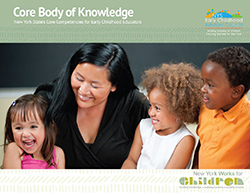
Core Body of Knowledge
New York State's Core Competencies for Early Childhood Educators

4.2
Resources for Competency 4.2:
click to view resource list
Creates Environment Responsive to Children
The professional working with young children creates an environment that is predictable, promotes interaction and learning, and is responsive to children's needs
Resources & Media for Understanding Competency 4.2
Behaviors & Skills
-
aDesigns schedules that are predictable but flexible and reflect children's right to fresh air, physical activity, rest, and nourishment
-
bUses a steady, calm tone when providing direction and redirection to children
-
cDevelops group rules with children and states the rules in a positive form and not in a negative form ("Walk, please" vs. "No running")
-
dImplements classroom rules with consistency
-
eConsistently uses a predictable signal to gain the attention of the group and regularly models the expected response
-
fUses a variety of strategies to engage children's attention and active participation
-
gEngages and maintains children's attention before and during communication (i.e., giving directions, speaking, beginning an activity, requesting information)
-
hSpeaks slowly, briefly and concisely clearly when giving directions
-
iMakes sure expectations for routines and tasks are clear and purposeful for all children before asking them to follow through
-
jTeaches the steps involved in routines and tasks: repeats directions; provides visual support while giving directions; and uses visual and/or verbal prompts to help children follow through when necessary
-
kObserves and guides the whole group during transitions, rather than focusing on individual children or preparing materials
-
lUses clear visual and auditory cues to support children during transitions
-
mKeeps transitions to a minimum, and makes them short, meaningful, and consistent
-
nUses positive guidance strategies to prevent challenging behavior from occurring
-
oEstablishes clear, consistent, and realistic boundaries based on developmentally appropriate expectations
